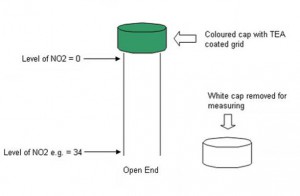We have asked for information on how air quality is tested and here is the City officer’s response.
Local Authorities throughout the country use diffusion tubes as a relatively low cost, easy to use method of monitoring nitrogen dioxide in the air. A diffusion tube is made of plastic and is 7.5cm long, and 1cm in diameter. Each end is sealed with a cap; one is coloured and the other is white.
When we are ready to monitor we take off the white cap and place the tube in position. This is often at the side of busy roads and we attach the tube using a plastic holder and tie wrap. Inside the coloured cap there is a metal grid that has been soaked with a special fluid called ‘triethanolamine’ or TEA. Once the tube is in position air is ‘drawn up’ into the tube by the process of molecular diffusion.
This works because the nitrogen dioxide in the air moves from a higher level at the open end of the tube to lower concentrations at the closed (coloured cap) end of the tube. The closed end always has a low level of NO2 because the TEA fluid on the grid absorbs this pollutant. When we have finished measuring, usually after one month, we put the white cap back on so no more NO2 will get in.
The time the tube is open is called the ‘exposure period’. The tube is sent to a laboratory where the NO2 is removed and measured. The result is the average NO2 in the air at that location for one month.
We currently have a network of over 50 diffusion tubes around Oxford monitoring the levels of nitrogen dioxide in the air.

